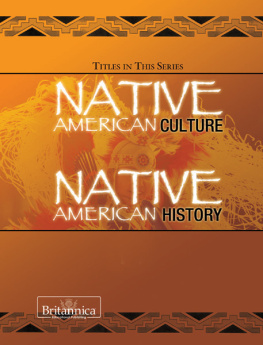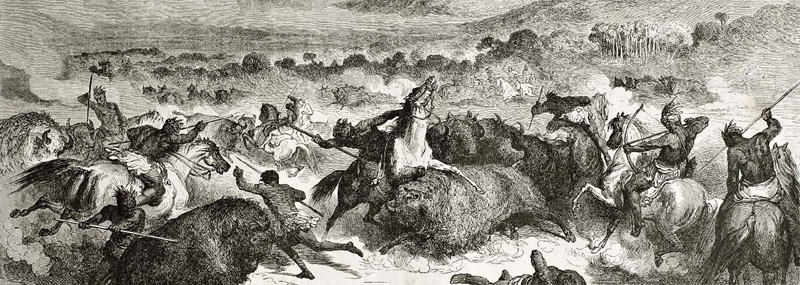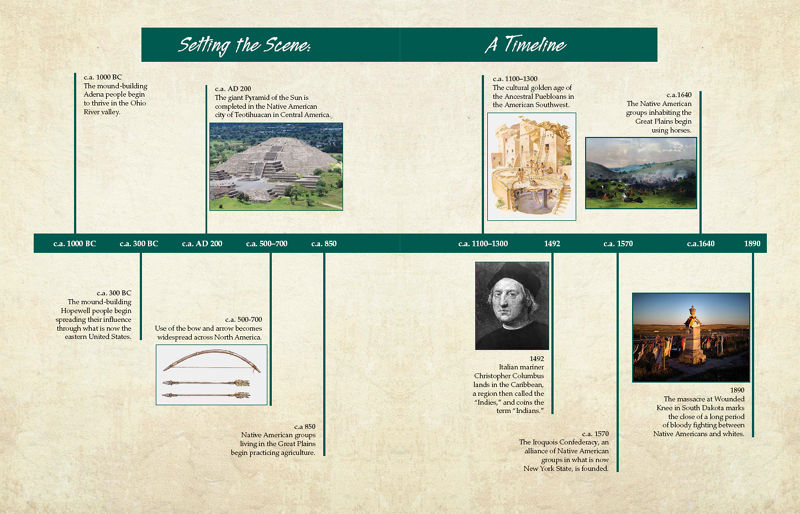Published in 2017 by
Lucent Press, an Imprint of Greenhaven Publishing, LLC 353 3rd Avenue Suite 255
New York, NY 10010
Copyright 2017 Greenhaven Press, a part of Gale, Cengage Learning
Gale and Greenhaven Press are registered trademarks used herein under license.
All new materials copyright 2017 Lucent Press, an Imprint of Greenhaven Publishing, LLC.
All rights reserved. No part of this book may be reproduced in any form without permission in writing from the publisher, except by a reviewer.
Designer: Deanna Paternostro
Editor: Katie Kawa
Cataloging-in-Publication Data
Names: Linde, Barbara M.
Title: Native Americans in early North America / Barbara M. Linde .
Description: New York : Lucent Press, 2017. | Series: American history | Includes index. Identifiers: ISBN 9781534560376 (library bound) | ISBN 9781534560383 (ebook) Subjects: LCSH: Indians of North America--History--Juvenile literature.
Classification: LCC E77.4 L56 2017 | DDC 970.00497--dc23
Printed in the United States of America
CPSIA compliance information: Batch #CW17KL: For further information contact Greenhaven Publishing LLC, New York, New York at 1-844-317-7404.
Please visit our website, www.greenhavenpublishing.com . For a free color catalog of all our high-quality books, call toll free 1-844-317-7404 or fax 1-844-317-7405.
Foreword
T he United States is a relatively young country. It has existed as its own nation for more than 200 years, but compared to nations such as China that have existed since ancient times, it is still in its infancy. However, the United States has grown and accomplished much since its birth in 1776. What started as a loose confederation of former British colonies has grown into a major world power whose influence is felt around the globe.
How did the United States manage to develop into a global superpower in such a short time? The answer lies in a close study of its unique history. The story of America is unlike any otherfilled with colorful characters, a variety of exciting settings, and events too incredible to be anything other than true.
Too often, the experience of history is lost among the basic facts: names, dates, places, laws, treaties, and battles. These fill countless textbooks, but they are rarely compelling on their own. Far more interesting are the stories that surround those basic facts. It is in discovering those stories that students are able to see history as a subject filled with lifeand a subject that says as much about the present as it does about the past.
The titles in this series allow readers to immerse themselves in the action at pivotal historical moments. They also encourage readers to discuss complex issues in American historymany of which still affect Americans today. These include racism, states rights, civil liberties, and many other topics that are in the news today but have their roots in the earliest days of America. As such, readers are encouraged to think critically about history and current events.
Each title is filled with excellent tools for research and analysis. Fully cited quotations from historical figures, letters, speeches, and documents provide students with firsthand accounts of major events. Primary sources bring authority to the text, as well. Sidebars highlight these quotes and primary sources, as well as interesting figures and events. Annotated bibliographies allow students to locate and evaluate sources for further information on the subject.
A deep understanding of Americas past is necessary to understand its present and its future. Sometimes you have to look back to see how to best move forward, and thats certainly true when writing the next chapter in the American story.
Introduction
A RICH AND COMPLEX HISTORY
N ative Americans are descended from people who journeyed from Asia to North America across a land bridge thousands of years ago. When exactly did they arrive? Groups of scientists and historians differ when it comes to answering that question. Some believe evidence points to a migration that began 23,000 years ago, while others believe the first of these people did not reach North America until 15,000 years ago or even sooner. More DNA research is needed to provide them with a clear answer.
Although the date of their arrival in North America is still unknown, much more is understood about what happened to these people once they arrived in the Western Hemisphere. Over time, they spread out across both North America and South America, settling in groups that adapted to their natural surroundings. These groups were all unique, with their own foods, customs, religions, and
social orders. Some lived as huntergatherers, but others eventually moved away from that nomadic lifestyle and began growing crops.
Life changed for Native Americans, who are also known as American Indians, when European settlers first arrived in the Western Hemisphere. These new settlers brought guns and other advanced weapons with them, which were used to help defeat the Native Americans and conquer their lands. In addition, Europeans brought diseases that Native Americans had no cure for or immunity to, such as smallpox, which wiped out huge portions of their population.
With their lands taken over and their numbers greatly reduced, the rich history of Native Americans was ignored for a long time. Over time, however, that mindset changed. Today, we know that the history of Native Americans in North America is rich and complex, and it is an important part of American history. As archaeologists continue to dig up artifacts left behind by Native Americans, it becomes easier to find the answers to questions about how they lived their lives before and after they first came into contact with Europeans. As such, an important part of American history has been preserved for future generations.
The past was filled with loss for Native Americans, and the present is filled with new struggles, but also a deep sense of cultural pride. However, the future looks even brighter because of the promise of deeper understanding.
Different Opinions on Archaeology
Although archaeological finds are helping people better understand and respect Native American history and culture, the work of unearthing the secrets of the ancient Native Americans is sometimes hampered by what is best described as a culture gap between archaeologists and Native Americans. Some groups have their own archaeologists. The Zunis and Hopis in the southwestern United States, for example, conduct digs and studies related to their own histories, and the Mashantucket Pequots in Connecticut have operated an extensive archaeological program on their reservation since 1983. Among other discoveries, they found the remains of a fort that was in use around 1675. Thousands of artifacts unearthed by the excavators can be seen in the tribes museum, which opened in 1998.
These tribal excavations are the exception rather than the rule, though. Most archaeologists who dig up the remains of past Native American cultures are not Native Americans. As such, many Native Americans view their excavations with some degree of suspicion and discomfort. This stems mainly from a difference in the way Native Americans and non-Native Americans view digging up the graves and handling the remains of buried ancestors. Most white archaeologists believe that such excavations are justified because they advance human knowledge. In contrast, many Native Americans see tampering with burial sites as a serious spiritual violation. The field of archaeology is a discipline that has been little understood in the Native American community, Zuni scholar Edmund J. Ladd pointed out. Ladd continued,

















